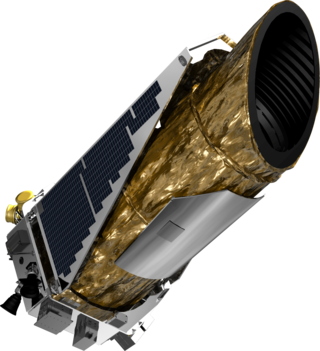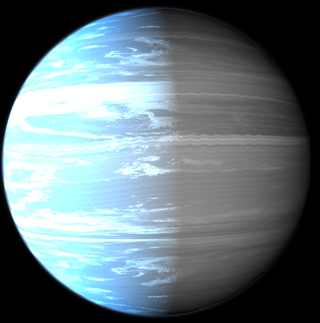Related Research Articles

An exoplanet or extrasolar planet is a planet outside the Solar System. The first possible evidence of an exoplanet was noted in 1917, but was not recognized as such. The first confirmation of the detection occurred in 1992. A different planet, initially detected in 1988, was confirmed in 2003. As of 1 September 2023, there are 5,506 confirmed exoplanets in 4,065 planetary systems, with 878 systems having more than one planet. The James Webb Space Telescope (JWST) is expected to discover more exoplanets, and also much more about exoplanets, including composition, environmental conditions and potential for life.

The Kepler space telescope is a disused space telescope launched by NASA in 2009 to discover Earth-sized planets orbiting other stars. Named after astronomer Johannes Kepler, the spacecraft was launched into an Earth-trailing heliocentric orbit. The principal investigator was William J. Borucki. After nine and a half years of operation, the telescope's reaction control system fuel was depleted, and NASA announced its retirement on October 30, 2018.

An exomoon or extrasolar moon is a natural satellite that orbits an exoplanet or other non-stellar extrasolar body.

TrES-2b (Kepler-1b) is an extrasolar planet orbiting the star GSC 03549-02811 located 750 light years away from the Solar System. The planet was identified in 2011 as the darkest known exoplanet, reflecting less than 1% of any light that hits it. Reflecting less light than charcoal, on the surface the planet is said to be pitch black. The planet's mass and radius indicate that it is a gas giant with a bulk composition similar to that of Jupiter. Unlike Jupiter, but similar to many planets detected around other stars, TrES-2b is located very close to its star and belongs to the class of planets known as hot Jupiters. This system was within the field of view of the Kepler spacecraft.

Any planet is an extremely faint light source compared to its parent star. For example, a star like the Sun is about a billion times as bright as the reflected light from any of the planets orbiting it. In addition to the intrinsic difficulty of detecting such a faint light source, the light from the parent star causes a glare that washes it out. For those reasons, very few of the exoplanets reported as of April 2014 have been observed directly, with even fewer being resolved from their host star.

A Super-Earth is a type of exoplanet with a mass higher than Earth's, but substantially below those of the Solar System's ice giants, Uranus and Neptune, which are 14.5 and 17 times Earth's, respectively. The term "super-Earth" refers only to the mass of the planet, and so does not imply anything about the surface conditions or habitability. The alternative term "gas dwarfs" may be more accurate for those at the higher end of the mass scale, although "mini-Neptunes" is a more common term.

HD 189733 b is an exoplanet in the constellation of Vulpecula approximately 64.5 light-years (19.8 pc) away from our Solar System. Astronomers in France discovered the planet orbiting the star HD 189733 on October 5, 2005, by observing its transit across the star's face. With a mass 16.2% higher than that of Jupiter and a radius 13.8% greater, HD 189733 b orbits its host star once every 2.2 days at an orbital speed of 152.5 kilometers per second, making it a hot Jupiter with poor prospects for extraterrestrial life.
This page describes exoplanet orbital and physical parameters.

HAT-P-7b is an extrasolar planet discovered in 2008. It orbits very close to its host star and is larger and more massive than Jupiter. Due to the extreme heat that it receives from its star, the dayside temperature is predicted to be 2,630–2,880 K K, while nightside temperatures are 2,211–2,238 K. HAT-P-7b is also one of the darkest planets ever observed, with an albedo of less than 0.03—meaning it absorbs more than 97% of the visible light that strikes it.

A hot Neptune or Hoptune is a type of giant planet with a mass similar to that of Uranus or Neptune orbiting close to its star, normally within less than 1 AU. The first hot Neptune to be discovered with certainty was Gliese 436 b in 2007, an exoplanet about 33 light years away. Recent observations have revealed a larger potential population of hot Neptunes in the Milky Way than was previously thought. Hot Neptunes may have formed either in situ or ex situ.

HAT-P-11b is an extrasolar planet orbiting the star HAT-P-11. It was discovered by the HATNet Project team in 2009 using the transit method, and submitted for publication on 2 January 2009.

Kepler-7b is one of the first five exoplanets to be confirmed by NASA's Kepler spacecraft, and was confirmed in the first 33.5 days of Kepler's science operations. It orbits a star slightly hotter and significantly larger than the Sun that is expected to soon reach the end of the main sequence. Kepler-7b is a hot Jupiter that is about half the mass of Jupiter, but is nearly 1.5 times its size; at the time of its discovery, Kepler-7b was the second most diffuse planet known, surpassed only by WASP-17b. It orbits its host star every five days at a distance of approximately 0,06 AU. Kepler-7b was announced at a meeting of the American Astronomical Society on January 4, 2010. It is the first extrasolar planet to have a crude map of cloud coverage.
Kepler-5 is a star located in the constellation Cygnus in the field of view of the Kepler Mission, a NASA project aimed at detecting planets in transit of, or passing in front of, their host stars as seen from Earth. One closely orbiting, Jupiter-like planet, named Kepler-5b, has been detected around Kepler-5. Kepler-5's planet was one of the first five planets to be discovered by the Kepler spacecraft; its discovery was announced on January 4, 2010 at the 215th meeting of the American Astronomical Society after being verified by a variety of observatories. Kepler-5 is larger and more massive than the Sun, but has a similar metallicity, a major factor in planet formation.

An exoplanet is a planet located outside the Solar System. The first evidence of an exoplanet was noted as early as 1917, but was not recognized as such until 2016; no planet discovery has yet come from that evidence. What turned out to be the first detection of an exoplanet was published among a list of possible candidates in 1988, though not confirmed until 2003. The first confirmed detection came in 1992, with the discovery of terrestrial-mass planets orbiting the pulsar PSR B1257+12. The first confirmation of an exoplanet orbiting a main-sequence star was made in 1995, when a giant planet was found in a four-day orbit around the nearby star 51 Pegasi. Some exoplanets have been imaged directly by telescopes, but the vast majority have been detected through indirect methods, such as the transit method and the radial-velocity method. As of 1 September 2023, there are 5,506 confirmed exoplanets in 4,065 planetary systems, with 878 systems having more than one planet. This is a list of the most notable discoveries.
Kepler-12b is a hot Jupiter that orbits G-type star Kepler-12 some 900 parsecs (2,900 ly) away. The planet has an anomalously large radius that could not be explained by standard models at the time of its discovery, almost 1.7 times Jupiter's size while being 0.4 times Jupiter's mass. The planet was detected by the Kepler spacecraft, a NASA project searching for planets that transit their host stars. The discovery paper was published on September 5, 2011.
Kepler-47 is a binary star system in the constellation Cygnus located about 3,420 light-years away from Earth. The stars have three exoplanets, all of which orbit both stars at the same time, making this a circumbinary system. The first two planets announced are designated Kepler-47b, and Kepler-47c, and the third, later discovery is Kepler-47d. Kepler-47 is the first circumbinary multi-planet system discovered by the Kepler mission. The outermost of the planets is a gas giant orbiting within the habitable zone of the stars. Because most stars are binary, the discovery that multi-planet systems can form in such a system has impacted previous theories of planetary formation.
Kepler-68d is a gas giant with the minimum mass about the same as Jupiter. It is at least a jovian-mass planet orbiting 1.4 astronomical units from its parent star, Kepler-68, well within habitable zone of the star. It was detected by radial velocity.
Kepler-43,formerly known as KOI-135, is a star in the northern constellation of Cygnus. It is located at the celestial coordinates: Right Ascension 19h 00m 57.8034s, Declination +46° 40′ 05.665″. With an apparent visual magnitude of 13.996, this star is too faint to be seen with the naked eye. The Kepler-43 has a very strong starspot activity.

K2-33b is a very young super-Neptune exoplanet, orbiting the pre-main-sequence star K2-33. It was discovered by NASA's Kepler spacecraft on its "Second Light" mission. It is located about 456 light-years away from Earth in the constellation of Scorpius. The exoplanet was found by using the transit method, in which the dimming effect that a planet causes as it crosses in front of its star is measured.

WASP-76b is an exoplanet classified as a Hot Jupiter. It is located in the constellation Pisces and orbits its host star, WASP-76, at a distance of approximately 0.033 astronomical units (AU). The orbital period of WASP-76b is approximately 1.8 days. Its mass is about 0.92 times that of Jupiter. The discovery of WASP-76b took place on October 21, 2013, and it is currently the only known planet in the WASP-76 system as of 2022. The equilibrium temperature of WASP-76b is estimated to be around 2,190 K, However, the measured daytime temperature is higher, reaching approximately 2,500 ± 200 K.
References
- 1 2 Jackson, Brian; Adams, Elisabeth; Sandidge, Wesley; Kreyche, Steven; Briggs, Jennifer (2019), "Variability in the Atmosphere of the Hot Jupiter Kepler-76b", The Astronomical Journal, 157 (6): 239, arXiv: 1905.07781 , Bibcode:2019AJ....157..239J, doi: 10.3847/1538-3881/ab1b30 , S2CID 159041579
- 1 2 Faigler, S.; et al. (2013). "BEER Analysis of Kepler and CoRoT Light Curves. I. Discovery of Kepler-76b: A Hot Jupiter with Evidence for Superrotation". The Astrophysical Journal. 771 (1). 26. arXiv: 1304.6841 . Bibcode:2013ApJ...771...26F. doi:10.1088/0004-637X/771/1/26. S2CID 119247392.
- ↑ "New Method of Finding Planets Scores its First Discovery". kepler.nasa.gov. Archived from the original on November 23, 2013. Retrieved May 14, 2013.



